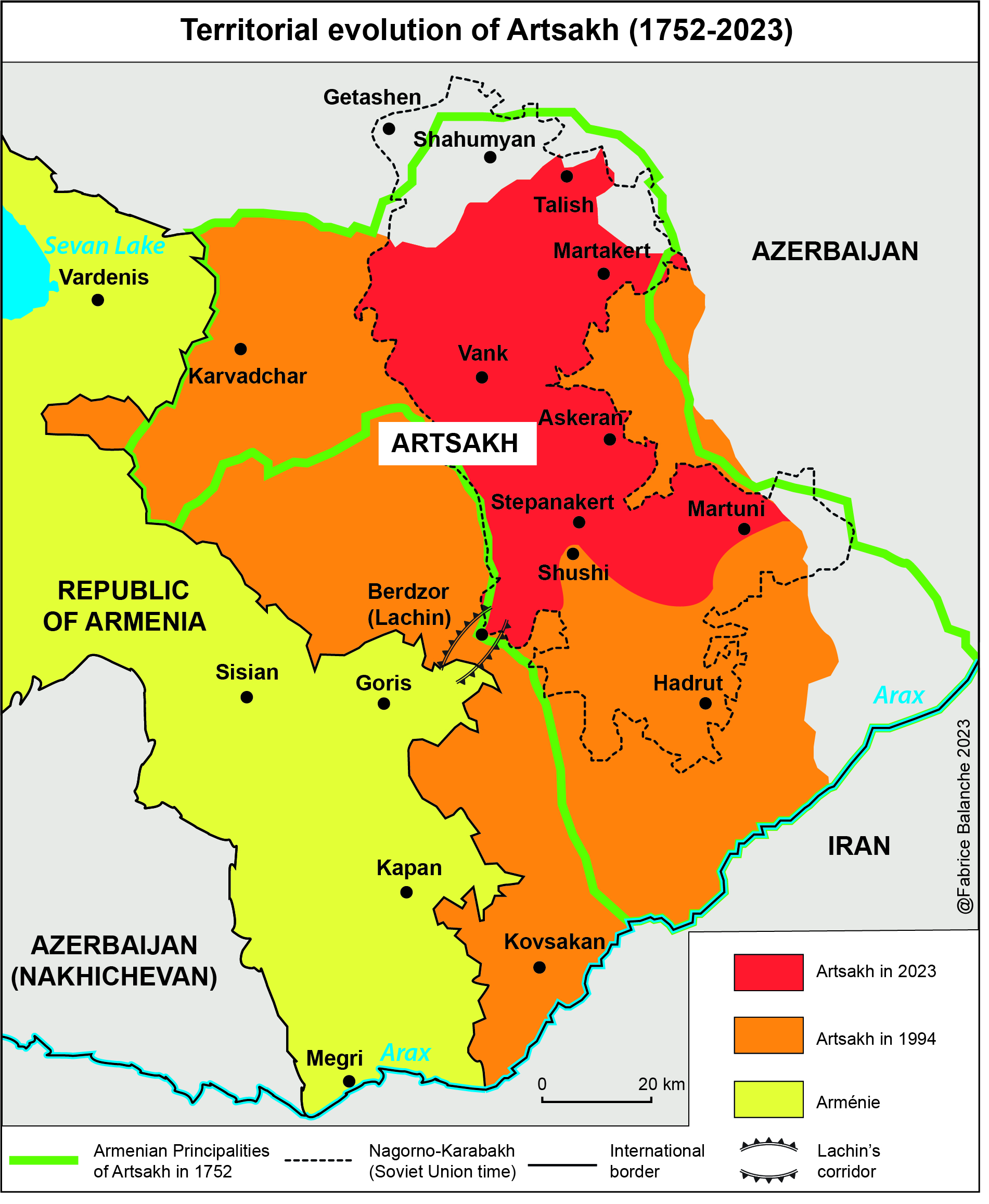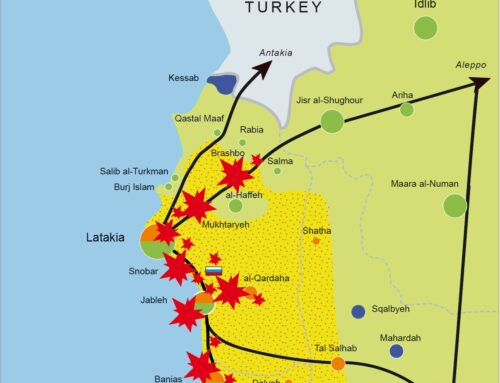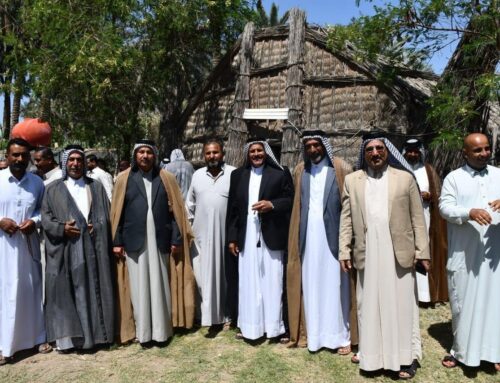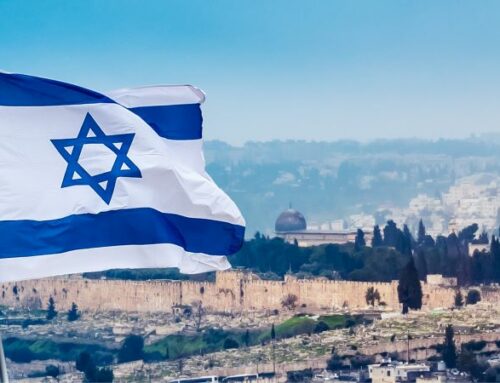Syrian mercenaries against Karabakh
Article published in Haut-Karabakh: le livre noir, edited by Eric Denécée and Tigrane Yégavian. Ellipses, French Center for Intelligence Research, Paris, 2022
During its offensive against Karabakh, Azerbaijan used Syrian mercenaries. They transited through Turkey, which brought them from North-West Syria thank to military plane to Azerbaijan. So far Turkey and Azerbaijan, through the voice of President Ilham Alyev, deny[1] this use of Syrian mercenaries. However various sources confirmed that, as evidenced with a detailed report sent to the United Nations Security Council by Armenia on December 10, 2020[2]. Some mercenaries were taken prisoner, which constitutes irrefutable proof of their presence on the frontline[3]. Various Western media, such as The Guardian[4], France 24[5], BBC[6], Le Monde, etc. collected testimonies. In Syria, several media close to the opposition, such as the Syrian Observatory for Human Rights[7], have also confirmed the participation of Syrian fighters. Finally, the European Parliament condemned twice on January 27, 2021[8] and March 11, 2021[9], the recruitment of Syrian mercenaries by Turkey and their use in Libya and Karabakh.
Baku’s refusal to recognize the truth can be explained for several reasons. On the one hand, the use of mercenaries is condemned by the UN while Azerbaijan claims that its offensive against “the separatist republic” is legitimate. On the other hand, does this mean that the Azerbaijani army was not strong enough to win the war without the contribution of foreign fighters? Attack being the best defense, Azerbaijan, on the other hand, accused Armenia of using Syrian Kurds to defend itself[10]. Finally, Turkey also remains silent as it is the linchpin of this aggression against Karabakh. However, this is not the first time that Turkey has used Syrian mercenaries, as in Libya during spring 2020 where several thousand Syrian fighters supervised by Turkish military advisers went to support the militias of Tripolitania against the Marshal Haftar’s. This Turkish aid was essential to save Fayez el-Sarraj’s government which had just signed an agreement with Turkey, to the detriment of Greece and Cyprus, on the sea sharing in the eastern Mediterranean.

In general, States are rather discreet about the mercenaries use in their external operations. Whether it is the United States with Black water[11] in Iraq, Russia with the Wagner group, Iran with the Hazaras[12], etc. The main advantage of mercenaries is that it is not necessary to ask a vote from parliament or an official decision to be able to hire them, unlike the regular army, including for the Islamic Republic of Iran. On the ground, clashes between mercenaries reduce tensions between state actors and vis-à-vis its own population, because it is not nationals who are killed. Last but not least, it releases governments from any responsibility in the event of abuses. Mercenaries are then quickly sent back to their native country, which prevents any possibility of an international investigation. Mercenaries are therefore often engaged in gray areas and questionable affairs. Their number and identity are kept secret, if not simply denied. The Syrian mercenaries engaged against Karabakh correspond perfectly to that situation.
Cannon fodder
Syrian mercenaries in Karabakh are estimated between 1,000 and 4,000 men by various sources. This represents only a small percentage of the forces engaged against the Armenians, since the Azerbaijani army is estimated to 100,000 men. The Syrians were sent to the front line as evidenced with the number of dead: 540 according to the SOHR, nearly 20% of the losses on the Azeri side, estimated to 3,000 [13], because Azerbaijan does not has not issued an official report. The testimonies collected indicate that the Syrians only had light weapons and they had no air support nor armored vehicles. They were mainly used in southern Karabakh, on the Iranian border, to open a way along Lachin corridor and towards Nachichevan, at least up to the border with the Republic of Armenia.
It was in this flat, sparsely forested and sparsely populated region that Azeri forces launched their major offensive, then took Soshi and threatened Stepanakert. It was much more difficult to break through the Armenian defenses to the east and north of Karabakh, whose rugged terrain and thick forests provided natural protection against drones and helicopters. The progress of Azeri forces in the south, in open field, was bloody. Good sky cover and the massive use of artillery could have limited the losses, however Iranian territory must not suffer collateral damage. The Islamic Republic was hostile to the Azeri intervention against Karabakh, a simple violation of its airspace could have triggered a military response. From the start of the fighting, Iran had deployed large armed forces to its northern border. This constitutes an additional reason to deploy Syrian mercenaries in this area, because if they were killed by an Iranian strike, it would not have led to a major political crisis with the powerful neighbor.
The losses suffered by the Syrians quickly discouraged the fighters from going to the front, especially since the wounded men were not properly treated and died. The testimonies support the idea that Azerbaijan used the Syrians as cannon fodder. They were systematically placed on the front line and used in open field where Azeri officers were reluctant to send the national army, because losses had to be avoided as much as possible. Mutinies eventually broke out among Syrian mercenaries who refused to be sent to death a sheep. The mutineers were threatened with imprisonment and ended up being sent back to Syria[14] without any pay. Originally, they had come from Syria to escape poverty, and some in the hope of obtaining Turkish nationality.
Mercenaries are from North West Syria
The mercenaries sent to Azerbaijan come from the Turkish-controlled regions of northwestern Syria as well as from the Idlib pocket dominated by the jihadist group Hayat Tahrir al Sham. This area has around 4 million inhabitants who live in very precarious conditions. More than half of them are internally displaced. They left East Aleppo, Deraa, the suburbs of Damascus, the countryside of Homs and Hama during the Syrian Army reconquest. Most are linked to rebel and jihadist groups, so they cannot return to their areas of origin where they are considered as traitors. They are stocked in northwestern Syria because Turkey has erected a wall on its border with Syria. Ankara refuses a new wave of migration from Syria which would be added to the four million already present. Admittedly, Turkey could let them transit to the European Union, which the majority of them hope for. However, the EU learned the lesson from the great migration of 2015 and ended up barricading the border with Turkey: Erdogan’s attempt to push tens of thousands of migrants to Europe in February 2020 thus failed. Finally, such an operation would put an end to the Turkish blackmail with regard to the European Union.
Northwestern Syria is surviving thanks to international humanitarian aid sent from Turkey. The majority of the population only has this aid to survive. According to the United Nations[15], out of a total of 4 million inhabitants, 2.9 are internally displaced people who live in extreme precariousness. Work is scarce and very poorly paid, so that the militias are the main employer in the region, whether in the direct occupation zone of Turkey or in Idlib [16] under Hayat Tahrir al-Sham control. A militiaman receives a hundred dollars a month. But in the absence of a new offensive, he can no longer bend at leisure as before. Furthermore, financial aid from the Gulf countries dried up with the victory of Bashar al-Assad and the growing hostility between Turkey and Saudi Arabia. As the strategic income dwindles, the rebel fighters have also become impoverished, which makes the salaries of $1,000 to $2,000 per month[17] offered by recruiting agents extremely attractive to go and fight in Libya and Azerbaijan.
In fact, Ankara hopes to use these Sunni Arab populations, along with a Turkmen minority, to build an anti-Kurdish Arab belt in northern Syria[18]. In March 2018, the Turkish army and its Syrian counterparts seized the Kurdish district of Afrin. The majority of the Kurdish population fled the fighting and those who remained were initially pushed by the exactions of the pro-Turkish militias[19]. The ethnic cleansing process also took place in the Tel Abyad – Ras al-Ain strip, conquered by Turkey in October 2019. The lands and dwellings abandoned by the Kurds are then occupied by the families of pro-Turkish fighters . Erdogan intends to continue the conquest of the Kurdish territories of northern Syria: Kobané and Upper Jezireh around Qamechli, expelling the Kurdish populations about thirty kilometers from his border, that is to say in the desert area. . However, it comes up against Russia and the United States, which for different reasons have so far refused any new offensive. It is therefore necessary to occupy the tens of thousands of idle militiamen.
Financial motivation takes precedence
The mercenaries sent to Azerbaijan mainly come from brigades integrated into the new “Syrian National Army” created by Turkey in 2019. These are the Sultan Murad brigade, made up of Turkmens, the al-Hamza brigade, Nour al Din al-Zinki, remnants of Ahrar al-Sham and other groups qualified as “moderate Islamists” with regard to al-Qaeda and Daesh, but known for their exactions[20]. These militias were used on different fronts in Syria, against the Syrian army and the Syrian Democratic Forces[21]. The militiamen are therefore seasoned in combat and even if they are far less disciplined than the Azeri soldiers, their lesser apprehension is a definite advantage. However, recruitment among the brigades already formed does not seem to have been sufficient since civilians were also recruited in large numbers. According to the recruiting agents of the company SADAT[22], close to the Turkish power, they were simply to be assigned to surveillance tasks in the rear. They did not have adequate military training and were therefore the first victims of the conflict. This lower quality of mercenary recruitment is explained by the widespread corruption that reigns in Syria. The Syrian recruiting agents gave the benefit of this hiring to those who agreed to pay them a 20% commission on their salary[23].
Everything indicates that these militiamen no longer have any political motivation. Originally, they joined the Syrian rebellion to fight Bashar al-Assad’s regime. However, their “revolutionary” ideal quickly evaporated if they had one at all. Looting, trafficking, racketeering, spoliation and the thirst for power quickly took over, preventing the unification of the Syrian rebels within a “Free Syrian Army” which existed only on paper and in wishes. pious Arab and Western donors. The lure of gain in their commitment alongside Turkey in Karabakh, in Libya, but also against the Syrian Democratic Forces in Syria, is therefore the main motivation of Syrian mercenaries. One can wonder about a possible religious motivation in the case of Karabakh, since it is a question of conquering a Christian territory, but on behalf of a Shiite country. This apparent contradiction is quickly resolved by unscrupulous Imams who find in the Koran and the Hadiths all the possible justifications to make the commitment legal. Other Imam condemns the commitment in Azerbaijan, such as Sheikh Abu Yakzan al-Mesri, a member of Hayat Tahrir al-Sham: “Abandoning Jihad to engage in a war between secular Shiites and a Christian army is a of the most fished”[24]. Has this had an impact on the recruitment of Syrians? The pool of unemployed young men is such that this has had no impact on the quantity, but may be on the quality of recruitment, since financial motivation alone is insufficient to make good fighters.
Turkey has prioritized recruiting fighters from Turkmens for linguistic convenience and because they are considered the most loyal to Ankara. The Sultan Mourad brigade was thus called upon. It therefore favored small units belonging to this brigade, because the fighters already had extensive combat experience in cooperation with the Turkish army, such as in Afrin, Tal Abiad and Idlib. Moreover, small units already constituted are immediately operational, which avoids a long and costly training, because the war is of short duration. Those who had already proven themselves in Libya were of course recruited first. On the other hand, Turkey does not seem to have solicited jihadist groups or fighters from these formations. However, the lure of profit and religious motivation is not lacking in the ranks of the jihadists. But Turkey would have taken a huge risk vis-à-vis Russia and Iran if it had transported individuals linked to al-Qaeda or Daesh to Azerbaijan. It therefore seems that Emmanuel Macron exaggerated when he announced on October 2, 2020, that Turkey had transferred 300 jihadists from Syria to Azerbaijan[25]. Unless the myth of “moderate Islamist” fighters, icons of the Syrian conflict and desired alternative to the Syrian regime, has finally fallen in France?
The future of Syrian mercenaries
Most of the Syrian mercenaries left Azerbaijan at the end of 2020. Once the military operations ended, it was no longer appropriate to keep these fighters there. It was precisely necessary to prevent them from settling and trying to bring their families to Azerbaijan. The Syrian mercenary is therefore not intended to receive a piece of land at the end of his engagement. He is remunerated for a service with a fixed-term contract and cannot claim any other compensation. In the event of death, his family receives a capital, but not a pension like regular combatants, which is much more economical. As for the injured, they do not receive a disability pension either, they are content to put them back on their feet. Those who return safely to Syria can, however, claim promotion within their brigade and are privileged for future missions abroad.
Turkey thus has an inexhaustible reservoir of mercenaries in northwestern Syria. Misery, precariousness and dependence on the Turkish authorities encourage recruitment. The use of mercenaries feeds the neo-Ottoman strategy of Recep Tayyip Erdogan who can thus intervene militarily in Libya in the Caucasus and in Somalia without risking the lives of thousands of Turkish soldiers. He therefore does not need to obtain a political consensus on these military operations or take Turkish public opinion into account. He has undoubtedly learned from previous operations in Syria, in the fall of 2016 against the Islamic State, where 70 Turkish soldiers died between September 2016 and March 2017, and against the SDF in Afrin from January to March 2018 (45 to 80 dead), which had aroused great emotion in Turkey. It therefore has less need for a Turkish army whose command it decimated after the failed coup of July 2016. In Libya, the Turkish army sent only a few dozen military advisers to supervise several thousand Syrian fighters. It was the same scenario in Azerbaijan. We are however still far from the reconstitution of a corps of janissaries, because the Syrian mercenaries lack cohesion and discipline. They are currently used on the margins of conflict, but their importance is growing. Turkey is thus following the example of Russia, whose Wagner group is also recruiting in Syria, and of the United States, which has largely used a private army in Iraq, where Latin Americans were numerous.
[1] https://president.az/en/articles/view/43037
[2] https://undocs.org/pdf?symbol=en/A/75/644
[3] Al Arabya,“Armenia captures two Syrian mercenaries, amid Turkish and Azerbaijani denials” , 11 November 2020 https://english.alarabiya.net/News/world/2020/11/13/Armenia-captures-two-Syrian-mercenaries-amid-Turkish-and-Azerbaijani-denials
[4] The Guardian, “Syrian rebel fighters prepare to deploy to Azerbaijan in sign of Turkey’s ambition”, 28 September 2020,
https://www.theguardian.com/world/2020/sep/28/syrian-rebel-fighters-prepare-to-deploy-to-azerbaijan-in-sign-of-turkeys-ambition
[5] https://observers.france24.com/en/20201026-videos-shared-social-media-show-syrians-sent-fight-nagorno-karabakh
[6] BBC, “The Syrian mercenaries used as ‘cannon fodder’ in Nagorno-Karabakh”, 10 December, 2020, https://www.bbc.com/news/stories-55238803
[7] Syrian Observatory for Human Rights, “Death toll of mercenaries in Azerbaijan is higher than that in Libya, while Syrian fighters given varying payments, 3 December 2020, https://www.syriahr.com/en/194516/
[8] https://www.europarl.europa.eu/doceo/document/TA-9-2021-0088_EN.html?fbclid=IwAR0KEtN_mcxsOg6vQWmZodgXwj15NZKpaFCb5OcAWCDZThi9ARoQM7-y17w
[9] https://www.europarl.europa.eu/doceo/document/TA-9-2021-0088_EN.html?fbclid=IwAR0KEtN_mcxsOg6vQWmZodgXwj15NZKpaFCb5OcAWCDZThi9ARoQM7-y17w
[10]APA “Azerbaijanis State Security Service announces facts proving fact that PKK terrorists fight on the Armenian side against Azerbaijan”, 6 October 2020, https://apa.az/en/xeber/accidents-incidents-news/SSS-announces-facts-approving-fighting-of-PKK-terrorists-on-the-Armenian-side-against-Azerbaijan-332242
[11] Scahill Jeremy, Blackwater: The Rise of the World’s Most Powerful Mercenary Army, Nation books, 2007
[12] The Hazaras are Afghan Shiites. Several million of them have been refugees in Iran for decades. Their living conditions are precarious and thousands of them have agreed to go and fight in Syria within the Fatimid Brigade (Liwa al-Fatimyun). Their motivation is above all financial with the added bonus of Iranian naturalization.https://araprism.org/2019/02/14/les-afghans-hazara-dans-le-conflit-syrien-lhistoire-dune-instrumentalisation-par-les-gardiens-de-la-revolution/
[13] Syrian Observatory for Human Rights, “Death toll of mercenaries in Azerbaijan is higher than that in Libya, while Syrian fighters given varying payments”, 3 December 2020, https://www.syriahr.com/en/194516/
[14] Syria Direct, “Destitution, deception thrust Syrians into the Azerbaijani-Armenian war in Nagorno-Karabakh region”, 12 October 2020
[15] https://reporting.unhcr.org/node/21129
[16] Balanche Fabrice, “Idlib May Become the Next Gaza Strip”, Washington Institute, 26 March 2020, https://www.washingtoninstitute.org/policy-analysis/idlib-may-become-next-gaza-strip
[17] Al-Monitor, “Why Syrians are joining Turkey in Nagorno-Karabakh clash”, 6 October 2020
https://www.al-monitor.com/originals/2020/10/syria-fighters-turkey-deploy-azerbaijan-armenia-russia.html
[18] Balanche Fabrice, « The Fragile Status Quo in Northeast Syria”, The Washington Institute, 1 July 2020, https://www.washingtoninstitute.org/policy-analysis/fragile-status-quo-northeast-syria
[19] United Nations – Human Rights, “Between a Rock and a Hard Place – Civilians in North-western Syria, June18 https://reliefweb.int/sites/reliefweb.int/files/resources/ohchr_-_syria_monthly_human_rights_digest_-_june_2018.pdf
[20] The Guardian, “Syrian opposition group that killed child ‘was in US-vetted alliance’”, 20 July 2016, https://www.theguardian.com/world/2016/jul/20/syrian-opposition-group-which-killed-child-was-in-us-vetted-alliance
[21] The Syrian Democratic Forces are a Kurdish-Arab coalition created in 2016 by the YPG (Syrian branch of the PKK) to fight against the Islamic State. In 2021, they control the northeastern third of Syria.
[22] Al-Monitor, “Syrian fighters add snarls to tangled south Caucasus”, 2 October 2020
https://www.al-monitor.com/originals/2020/10/turkey-russia-syria-fighter-transfers-azerbaijan-armenia.html
[23] The Guardian, “Syrian rebel fighters prepare to deploy to Azerbaijan in sign of Turkey’s ambition”, 28 September 2020,
[24] Al-Monitor, “Why Syrians are joining Turkey in Nagorno-Karabakh clash”, 6 October 2020
https://www.al-monitor.com/originals/2020/10/syria-fighters-turkey-deploy-azerbaijan-armenia-russia.html
[25] France 24, “Macron reprimands Turkey, accuses Erdogan of sending ‘jihadists’ to Azerbaijan”, 2 October 2020, https://www.france24.com/en/20201002-macron-reprimands-turkey-accusing-erdogan-of-sending-jihadists-to-azerbaijan





